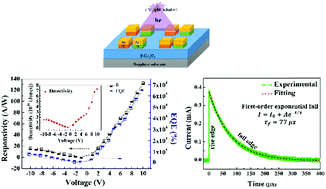A high-performance ultraviolet solar-blind photodetector based on a β-Ga2O3 Schottky photodiode†
Abstract
UV ray detection near the earth surface has become urgent due to the serious effects of UV rays on human health, the environment and the biological evolution; therefore, the development of energy-saving UV photodetectors with high responsivity, specific detectivity, and sensitivity is urgently desired. Herein, we fabricated a lateral β-Ga2O3 Schottky photodiode on a sapphire substrate via magnetron sputtering using Ti and Ni as ohmic and Schottky contacts, respectively. The photodiode shows rectifying behaviors in the dark and under 254/365 nm UV light illuminations. As a photodetector, it exhibits the high photo-to-dark current ratio of 2.83 × 105 owing to its low dark current (1.32 × 10−11 A) and strong UV absorbance. The responsivity at 250 nm could reach up to 144.46 A W−1 at 10 V. The external quantum efficiency of 64 711% and the ideal specific detectivity of 7.29 × 1014 cm Hz1/2 W−1 (Jones) were also achieved. The rejection ratio (R250 nm/R400 nm) was as high as 4.8 × 103, suggesting high wavelength selectivity. The responsivity of 2301.78 A W−1 at 180 V proves the ability of this photodetector to operate at high voltages. In addition, it can operate with the responsivity of 0.73 mA W−1 and the specific detectivity of 3.35 × 1010 cm Hz1/2 W−1 (Jones) at zero bias. Overall, the lateral Ti/β-Ga2O3/Ni structured Schottky photodiode was verified as an excellent candidate for UV solar-blind detection with high performance and low energy consumption.



 Please wait while we load your content...
Please wait while we load your content...